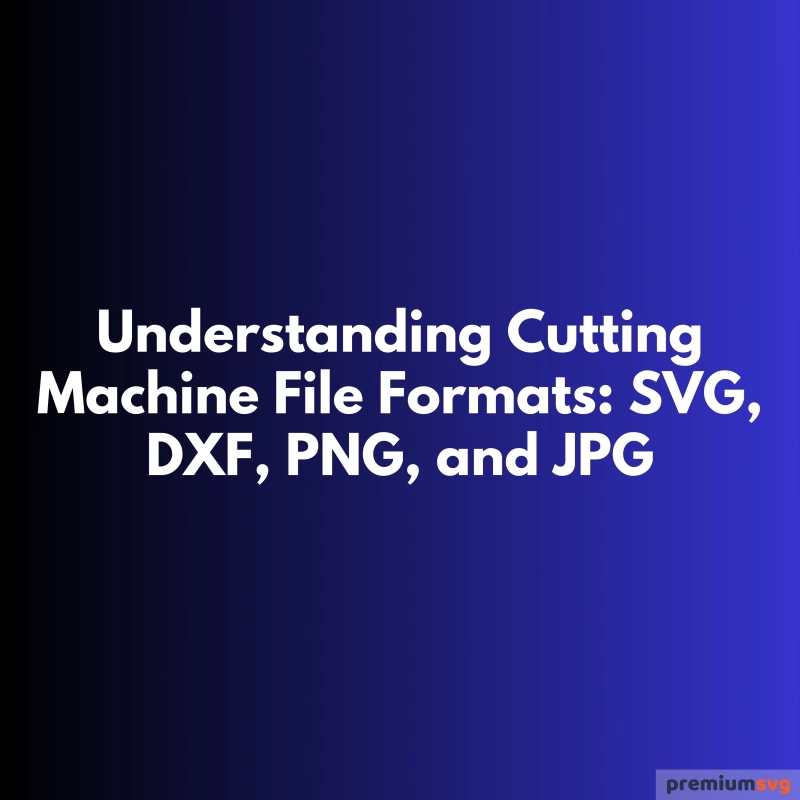File Formats of Cutting Machines: SVG, DXF, PNG, and JPG
There's more to using a cutting machine than just having the right tools. File format knowledge stands shoulder to shoulder with tool knowledge. Understanding the different file types and when to use each will make any crafting project easier and more successful. In this guide, we're going over the most common file formats that go along with cutting machines: SVG, DXF, PNG, and JPG—all their strengths, limitations, and best uses.
What is a cutting machine?
A cutting machine is a tool used to cut materials like paper, vinyl, fabric, and thin wood precisely. They can follow complex designs and create shapes that would be hard or impossible if done by hand.
Learn more "What is a cutting machine?"
What should be used to cut vector vs. raster images?
When it comes to cutting images, the choice between vector and raster files depends on both the type of cutting machine and the desired result. Each format has unique characteristics suitable for different cutting methods, as explained below.
Cutting Vector Images
Best for: SVG, DXF, AI, and EPS files
Cutting Machines: Cricut, Silhouette Cameo, Brother ScanNCut, and laser cutters
Why: Vector files are composed of paths, lines, and shapes defined by mathematical formulas. These paths provide specific guidance to a cutting machine, enabling it to cut cleanly and precisely regardless of the size.
Use Case: Intricate designs, text-based graphics, logos, and scalable shapes.
Check more about "What are vector files?"
Cutting Raster Images
Best for: PNG, JPG, and BMP files
Cutting Machines: Machines with print-and-cut functionality, like Cricut's Print Then Cut feature
Why: Raster files are based on pixels, which specify hue and shading but do not have cutting paths. For cutting, machines require an outline or a trace around the image provided mostly by software.
Use Case: Photorealistic prints, images with gradients, and designs requiring full-color details.
Check more about "What are raster images?"
Key Takeaway:
Use vector files (SVG/DXF) for precise cutting and scalability, and rely on raster files (PNG/JPG) for print-then-cut projects where detailed imagery is required. Always ensure your cutting machine supports the chosen file type for optimal results.
The Most Preferred Cutting Machine File Formats
We will categorize vector and raster images in this section, so let's start with the vector files.
Vector Files:
SVG (Scalable Vector Graphics)
Best For: Precision designs, multi-layered projects, and scalability.
SVG is the standard for cutting machines such as Cricut, Silhouette, and Brother. These files use vector graphics, meaning they can be sized up or down without losing any quality. Each shape, line, and layer in an SVG file can be edited independently, making it perfect for intricate designs.
Pros:
- It can be scaled without losing quality.
- It supports layers and multiple colors.
- It is editable with most design software.
Cons:
- Large file size with complicated designs.
- It always requires additional design software to complete its full customization.
Best Used For: Intricate designs, multi-layer vinyl projects, and detailed papercrafts.
DXF (Drawing Exchange Format)
Best For: Detailed line work and compatibility with CAD software.
DXF files are vector-based and can usually be found in Silhouette Studio because they are supported without requiring an upgrade. This makes them perfect for designs requiring fine lines and exact measurements.
Pros:
- They maintain perfect line details.
- Compatible with many design and CAD programs.
- Excellent for outline-centric projects.
Cons:
- Does not support colors or layers.
- Larger files can slow down software.
Best Used For: Outlined designs, engraving projects, and technical patterns.
Raster Files:
PNG (Portable Network Graphics)
Best For: Print-then-cut designs and transparent backgrounds.
PNG files are raster-based and best known for their transparent backgrounds. They're excellent for print-then-cut projects where a design needs to be printed first and then precisely cut around.
Pros:
- Supports transparent backgrounds.
- High-resolution image quality.
- Great for print-then-cut designs.
Cons:
- Not scalable without losing quality.
- Limited customization for cutting paths.
Best Used For: Stickers, print-then-cut designs, and photo-based projects.
JPG (Joint Photographic Experts Group)
Best For: Photo-based projects and simple print designs.
JPG files are another raster format but without transparency support. They're widely used for photo-based designs or simple print-and-cut projects.
Pros:
- Small file size.
- Universally supported across devices.
- Good for photo-rich designs.
Cons:
- No transparency support.
- Loses quality when resized.
- Limited customization for cutting paths.
Best Used For: Photo projects, simple print designs, and decorative prints.
Quick Comparison Table
| Format | Type | Best For | Scalable? | Supports Layers? | Transparency? |
|---|
| SVG | Vector | Precision designs | Yes | Yes | No |
| DXF | Vector | Line-focused designs | Yes | No | No |
| PNG | Raster | Print-then-cut | No | No | Yes |
| JPG | Raster | Photo projects | No | No | No |
Final Thoughts
With each of these file formats comes strengths and a generally recognized ideal use. SVG is best for intricate and scalable designs, while DXF can be used for outlines and more technical details. PNG should be used for print-then-cut projects that rely on transparency, and JPG for photo-based designs.
Knowing these file formats means a smoother workflow, better design results, and fewer hair-pulling moments with your cutting machine. As premiumsvg, we offer thousands of cutting machine files, you can simply Buy SVG and get other file formats as well! Happy crafting!



Comments
No Comments